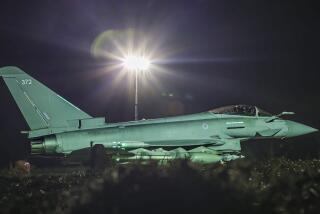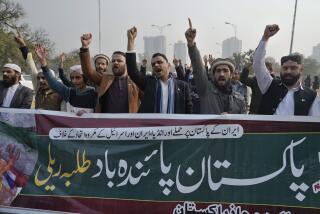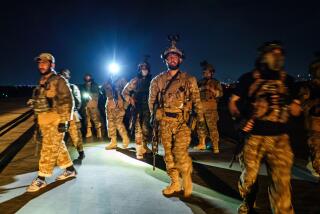9 U.S. troops die in Afghan attack
- Share via
KABUL, AFGHANISTAN — Insurgents armed with machine guns, mortars and rocket-propelled grenades mounted a fierce assault on a remote, relatively lightly manned U.S. outpost in northeastern Afghanistan on Sunday, killing nine American soldiers.
It was the largest loss of U.S. troops’ lives in a single incident in Afghanistan since June 2005, when 16 Americans died in the same province when a helicopter was shot down. The province, Kunar, is a swath of forbidding, mountainous terrain that borders Pakistan.
Reflecting the seriousness of the incident, Defense Secretary Robert M. Gates was briefed early Sunday on the assault, said Geoff Morrell, the Pentagon spokesman. Morrell described the casualties suffered by U.S. and Afghan forces as “significant,” but noted they had successfully repelled the attack.
The NATO-led International Security Assistance Force, or ISAF, reported the deaths of nine of its soldiers without specifying their nationalities. But a senior Defense Department official and a U.S. military official in Afghanistan, both speaking on condition of anonymity because they were not authorized to publicly discuss the incident, confirmed the dead were Americans. Fifteen Americans and four Afghan soldiers were wounded.
Although the attackers were driven back, the toll they exacted was undeniably heavy. The senior Defense Department official said the outpost was manned by 45 American troops and 25 Afghan soldiers. That would mean that one in five of the American defenders were killed and one-third wounded.
NATO divides Afghanistan into regional commands, and the eastern part of the country, including Kunar province, is under U.S. military control.
Although Afghanistan’s south is the traditional heartland of the Taliban insurgency, the east has seen a sharp surge in attacks over the last few months. NATO has linked the increase to peace negotiations being conducted by Pakistani authorities with Taliban militants who shelter in the tribal lands on the Pakistani side of the border.
The chairman of the Joint Chiefs of Staff, Navy Adm. Michael G. Mullen, visited Pakistan last week and emphasized U.S. concerns about the flow of fighters and weaponry from the tribal areas.
NATO has also accused the insurgents in Pakistan of deliberately seeking to fuel tensions by directing fire across the border at Western troops in Afghanistan. Last month, 11 Pakistani paramilitary troops were killed when coalition troops called in airstrikes after being fired on, an incident that drew an angry protest from Pakistan’s new government.
Taliban fighters and other Islamic insurgents have been trying for more than six years to dislodge foreign troops from Afghanistan and reestablish rule based on their austere vision of Islam. This year has been the most violent since the 2001 U.S.-led invasion that drove the Taliban from power.
In the Kunar assault, the insurgents were believed to have suffered heavy casualties, ISAF said in a statement. The well-organized attack began before dawn and raged for hours before tapering off late in the day, military officials said. Coalition officials had not made a “final assessment” of the confrontation, ISAF added.
The attack was unusual in its audacity. Taliban guerrillas rarely make sustained frontal assaults on much better-armed coalition forces, preferring hit-and-run attacks and roadside bombs. But militants do make occasional attempts to overrun outposts, particularly if their surveillance indicates that there are relatively few troops inside, or they are aware that terrain or location might make it difficult for Western forces to conduct airstrikes or bring in reinforcements.
It would be considered an enormous battlefield coup for the insurgents to capture a coalition base, particularly if they are able to take captives and seize weaponry. Insurgents often videotape their attacks on Western forces and use the images in recruiting and propaganda videos.
Sunday’s deaths accelerated what had already been a rapidly rising fatality count among coalition troops in Afghanistan. During May and June, the 69 deaths among U.S. and other NATO troops in Afghanistan outnumbered American military fatalities in Iraq.
In addition to the Americans killed in Kunar province, an ISAF soldier died Sunday in Helmand province in southern Afghanistan, where most of the Western troops are British.
Amid the intensified combat between coalition forces and the Taliban, recent deadly attacks by insurgents in densely populated cities and towns have exacerbated ordinary Afghans’ sense of insecurity. Often the targets are security forces or official installations, but suicide strikes in crowded areas almost always exact a large civilian toll.
On Sunday, at least 24 people died and dozens were hurt when a suicide bomber targeted a police patrol in a crowded marketplace in Oruzgan province, local officials said. Six days earlier, 60 people were killed by a car bomb outside the Indian Embassy in Kabul.
Coalition military officials said that in the attack in Kunar province, insurgents fired from homes and a mosque in the village of Wanat, near the American outpost. ISAF accuses Taliban militants of routinely using civilian areas as a staging ground for attacks, placing those who live there at great risk. It was not known whether villagers were present during the attack, or if they had fled.
The uneven pace and intensity of fighting in various parts of Afghanistan have led to friction within the North Atlantic Treaty Organization over whether the burden of combat duty falls disproportionately on some member forces.
British, Canadian and Dutch troops, bolstered by more than 2,000 U.S. Marines deployed during the spring, do most of the fighting in the south, and U.S. forces are the main element in the east.
--
Special correspondent Faiez reported from Kabul and Times staff writer King from Istanbul, Turkey. Staff writer Peter Spiegel in Washington contributed to this report.
More to Read
Sign up for Essential California
The most important California stories and recommendations in your inbox every morning.
You may occasionally receive promotional content from the Los Angeles Times.










